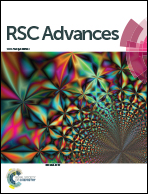One-step synthesis of poly(ethyleneglycol dimethacrylate)-microspheres-supported nano-Au catalyst in methanol–water solution under γ-ray radiation†
Abstract
A sub-micron sized highly-crosslinked poly(ethyleneglycol dimethacrylate) (PEGDMA) microsphere supported nano-Au catalyst (PEGDMA@AuNP) was successfully prepared through a one-step synthesis method at room temperature and ambient pressure, taking advantage of the γ-ray radiation effect on a simple one-pot system, i.e. a methanol–water solution containing EGDMA, 4-VP, and HAuCl4. Electron microscopy, XPS, and XRD analyses proved that AuNPs of several nanometers had been synthesized and loaded simultaneously with the formation of crosslinked PEGDMA microspheres when the adsorbed dose rate and the initial concentration of HAuCl4 were controlled within a narrow range, i.e. 35–80 Gy min−1 and below 1 mmol L−1 of [HAuCl4]. The size of the prepared PEGDMA@AuNP microspheres changed little with the dose rate, but decreased with the initial [HAuCl4], from 900 nm at 0.1 mmol L−1 to 680 nm at 1 mmol L−1. At the same time, the size of AuNPs increases with the initial [HAuCl4], from 8 nm at 0.1 mmol L−1 to 35 nm at 1 mmol L−1. The prepared PEGDMA@AuNP microspheres can be dispersed stably in both water and organic solvent, CH3CN. They exhibit excellent catalytic efficiency not only on the reduction of Fe(CN)63− by NaBH4 in aqueous solution, but also on the cis–trans isomerization of azobenzenes in CH3CN at room temperature. A satisfactory repeatability of the catalytic performance of the prepared PEGDMA@AuNP microspheres was achieved in organic solvents. This work opens a new green simple and economic way to the synthesis of efficient and chemically-stable polymer-supported nano-metal catalysts.


 Please wait while we load your content...
Please wait while we load your content...